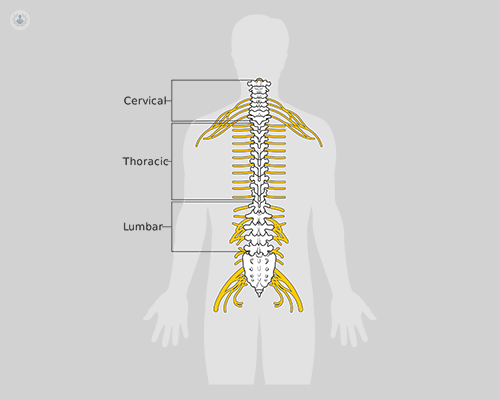Symptoms of tethered cord
Written by:The patient's symptoms with a tethered cord or lumbosacral lipoma are variable and depend largely on the age of onset and the severity of the malformation. At early ages, lipomas diagnosed primarily by cutaneous stigmata, while in older patients the symptoms are neurological because skin lesions may go unnoticed or be undervalued until the first symptoms arise.
- Cutaneous signs: The main cutaneous stigmas that are associated with lumbosacral lipomas are a mass in the lumbar region, hirsutism (abnormal hair strands), dimpling (dermal sinus), coccygeal appendices ( "human tails" or "tails") and / or capillary hemangiomas (vascular staining or "cravings").
Almost 90% of patients with a lipoma have at least one cutaneous manifestation, and most of them have several. The most common skin stigma associated with a lipoma is subcutaneous mass, consisting of a soft on disrrafismo package, which may be slightly asymmetric lateral and gluteal fold diverting.
Sacred fosita is a common finding that must be differentiated from dermal sinus. Those are located on the coccyx, in the midline cleft. Although described lipomas associated with the sacred pits, this association is rare, and in the absence of other signs do not need additional studies.

- Sensorimotor disorders: Although the birth many children are asymptomatic, it is accepted that the natural history of this malformation is towards a progressive deterioration, and this is the main reason for surgical indication when a tethered cord is associated. deficits can be found first and second motor neuron in the same affected limb, and progressive weakness with patchy altered sensitivity is a common finding in the evolution of these patients.
As a result of this neurological impairment, orthopedic deformities are an early sign, and often the first sign of deterioration alert. Due to an imbalance in the innervation of opposing muscle groups, up to a third of patients have equine-varus foot deformities and joint dislocations and shortening in the length of the feet or limbs. Scoliosis is present in 10% of patients and is progressive in case of spinal cord anchor. the continued evaluation of scoliotic curves that usually stop or reverse disembedding after surgery is recommended.
- Sphincter disorders: Impaired urological function is the most common neurological disorder in patients with lipomas complex, and affects up to 50% of them. It may manifest as recurrent urinary tract infections, incontinence or incomplete dissection of the bladder that result in the form of vesicoureteral reflux and chronic renal parenchymal renal impairment. Its detection is correlated with patient age (it is easier to recognize in older patients, they should have developed a complete continence) and the sensitivity of the diagnostic tools used. Often an altered urodynamic study may be the only anomaly present.
If detection is very early in younger children, bladder impairment may be reversible, but in older children and adults rarely an improvement is achieved after intervention beyond stabilizing the injury. The appearance of urological symptoms may be the first symptom of reembedding in a surgical patient before a spinal disrrafismo.
Alteration of fecal continence by hypotonic anal sphincter is less common, but most patients have some degree of constipation, which in the most severe degrees can cause overflow incontinence.
- Pain: The exception in younger children, but older children and young adults often have lumbar pain with irradiation erratic lower extremities. Characteristically the pain gets worse with exercise, stretching maneuvers or trauma.


